Mounts for the Display of Books
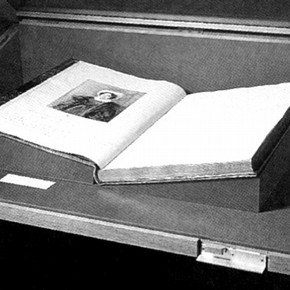
Figure 1. Book support made of museum board covered in the same cloth as the case lining, during installation
Until last year, there were basically two types of supports used to display books in the V&A. They had been developed, over a number of years, in order to prevent damage being caused to books whilst open on exhibition. The first is made of museum board covered with the cloth used on the inside of a showcase (Figure 1). Although bulky, it blends in with the case. It takes about one and a half hours to make. The other type is made of PerspexTM(ICI), taking between four and eight hours to make depending on the complexity of design (Figure 2).
Both types of cradle are made to fit a particular book open at a particular page. Both give full support to the boards and joints of a volume. Both have advantages and disadvantages, in terms of time, materials and aesthetics. Neither can be reused. Experience has shown that reuse for another volume with different dimensions and different opening characteristics can cause damage to the book, negating the very purpose of making supports.
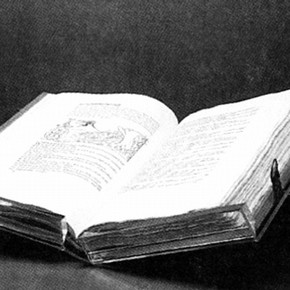
Figure 2. Perspex book support, with fore-edge lip and textblock support
A year ago there was a 'brainstorming' session to try and design the elusive universal cradle, which would fit any book and could be reused. Conservation mounters, paper and book conservators, curators and joiners came with various designs and materials. The ideal qualities were summarised as non-damaging and inert, cheap and reusable, easy and quick to use and aesthetically acceptable. Many ideas were suggested, based on some intriguing concepts ranging from deckchairs and the Rahl (the Islamic Koran stand), to a cribbage board, to using the pliable material used in 'Flexicurves'. The idea of some sort of kit emerged, with interchangeable components which could be reused. Designs were developed between each of the next three sessions, discussed and finally discarded in favour of two ideas. Danny Norman and Simon Fleury developed the two concepts and made enough prototypes to try them out at two different displays earlier this year. The following articles present the thinking behind the designs and give accounts of progress to date.
I worked through the various concepts following the list of criteria that the cradle should meet. The criteria included:
1. The cradle must support all parts of the book and ensure safe display;
2. Both sides must be independently adjustable in height and the angle from the horizontal at which the book can be displayed;
3. The overall design and choice of materials must be as inert and unobtrusive as possible to fit into any style of display in the future;
4. The cradle must be reusable and durable;
5. It must be easy to use, with the minimum amount of tools necessary, to set a book up;
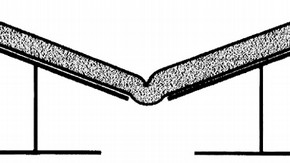
Figure 3. Prototype book cradle with telescopic legs. Illustrated by Danny Norman
Many concepts had excellent individual qualities, but most could not reach all the above criteria. For instance, a vacuum cushion used in Ceramics Conservation to hold objects whilst being worked on had unique moulding qualities that could have worked well for supporting an open book. Unfortunately, this, like many ideas, could not be worked up into a finished design. From this point I worked systematically through each design feature that was needed to meet the above prerequisites. To make the cradle adjustable in height, I opted for telescopic tubular legs (Figure 3). These were made from steel tube and rod of differing lengths sprayed black. These legs, like all the cradle parts, would be interchangeable between cradles, ensuring a flexible system of components to meet the needs of most books. To support the book boards, I decided on 6mm polished-edge Perspex sheet with a 10mm lip on the front edge to stop the book sliding forward. This element was decided upon as it was the only part that could not be adjustable in size and had to be the exact size of the book's boards for maximum support (these components will be cut down and reused for smaller books in the future). For continuity, Perspex plates were also used for the bases of the cradle, these too were 6mm polished-edge, drilled and the legs were bolted on. To make the book cradle adjustable to any angle I decided on a ball and socket fitting between the leg and the Perspex plate. For this I used a modified camera tripod fitting; again this was removable so the parts could be interchanged depending on the size and weight of book being displayed. Because of the accuracy needed to support the book and protect the spine, the cradle was made in two parts, these could then be positioned on either side of the book's spine.
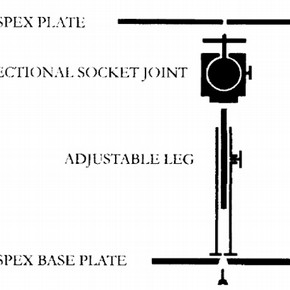
Prototype book cradle with telescopic legs. Illustrated by Danny Norman
To set the cradle up to the correct height and angle, four card templates were cut. These templates were placed on the inside and outside edges of the cradle and the two tightening nuts adjusted. The cradle was then ready to support the book.
During installation at the Royal College of Art's Centenary Exhibition some design problems were exposed and amendments made accordingly. Firstly, because of the weight and nature of an open book, the two parts of the cradle had a tendency to slip apart. To rectify this problem in the show, two small pins were placed on the outside edges of the cradle into the base of the case. Obviously this was not ideal, so two small holes have now been drilled in the corners of the base plates and a pin secures the two cradle halves together. In addition, although the card templates used to set the cradle worked well, they took a while to use so a new, faster method for setting up is being devised at present.

Figure 4. Prototype book cradle with slotted perspex combs and perspex wedges
The present method of cradle construction using board and cloth is fairly costly. Each cradle is made-to-measure, taking considerable time and is then discarded after use. It does however offer very good support for the book and apart from the cost of the cloth, the materials used are relatively inexpensive. When on display it is of little distraction, combining well with the cloth interiors of the display cases. Many of the available alternatives are made solely for a specific book, usually in Perspex and cannot be reused, or else they are over engineered and still not fully reusable.
I began by looking at the existing cradle and the basic requirements needed to safely support an opened book, with a view to adapting or simplifying the old method and possibly finding a less time-consuming, low-tech alternative. The task of finding a universal, fully reusable cradle seemed unrealistic.
I started building very basic models using slotted pieces of scrap card. Looking like skeletons of the board and cloth cradle these models took very little time to construct, they were quite sturdy but only offered minimal support to the book. The models and ideas were presented at the following cradle meeting and together with suggestions generated, it was decided to continue developing these prototypes.
It was apparent that the slotted base supports could be made from Perspex and be reused by matching them to the required length of the book to be displayed. The combs were fabricated from lengths of 10mm Perspex, with the slots milled at 5mm gaps and each slot 2mm wide to take museum board.
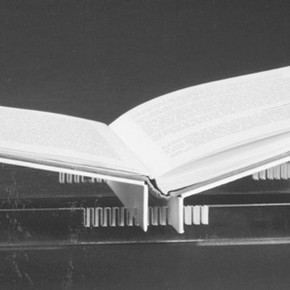
Figure 5. A book displayed on the slotted perspex support with museum board wedges
By experimenting with various ways of scoring and bending pieces of mount board to the dimensions of the books boards, it was possible to construct wedges that offered the correct support to the open book. The wedges are constructed by making two scored bends in the card, one at the spine edge and the other at the fore-edge of each of the boards of the book, taking into account the angles and dimensions for the required opening. The two board supports can then be slotted into the Perspex combs, leaving space for the spine. The supports can also be made from Perspex (Figure 4).
It was agreed to try this method on a National Art Library display. In practice, the method proved successful. The scoring and bending of the supports took minimal time and the cost of materials was low. Reservations were raised about the look of the board supports (Figure 5). It was felt that for some display situations the board could be distracting. With this in mind I approached the manufacturers of the Perspex combs to see if it was possible to make the wedge supports in Perspex. They were able to provide prototypes that slotted into the combs, supporting the book in the same way as the board models. Another possibility would be to use coloured mount board to match the interior case covering.
As an inexpensive and quick method of display this cradle works well. Using either the mount board supports or Perspex, the cradle can be adapted to varying display requirements. The main limitation on this design is in its blending-in with the overall look of the intended exhibition or display situation. With a collection of different lengths of the Perspex combs it should be possible to reuse them by matching them to the dimensions of the book.
Reference:Conservation Journal, Issue 22, January 1997
Authors: Helen Shenton, Danny Norman, Simon Fleury.













